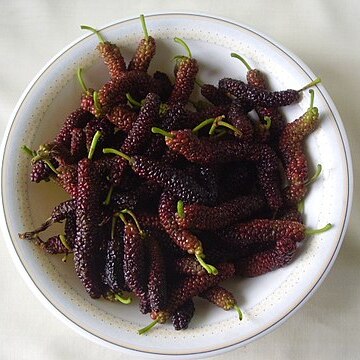Trees 7-12 m tall, d.b.h. 10-20 cm; dioecious. Branchlets pubescent when young. Winter buds ovoid-ellipsoid to ovoid, white pubescent. Stipules small. Petiole 2-4 cm; leaf blade ovate to broadly ovate, 5-15 × 5-9 cm, membranous, abaxially pale green and with short soft hairs along midvein and lateral veins when young, adaxially dark green and with soft hairs along veins, base rounded, ± cordate, or truncate, margin minutely and densely serrate, apex acuminate to shortly acuminate; secondary veins 4-6 on each side of midvein. Male catkins axillary, paired, 4-8 cm; peduncle 1-1.5 cm. Female inflorescences cylindric, 6-12 cm; peduncle 1-1.5 cm. Male flowers: calyx lobes ovate, adaxially pubescent; filament ca. 2.5 mm; anther globose. Female flowers: calyx lobes pubescent; ovary ovoid, declinate, ± compressed, pubescent; style absent; stigma 2-branched, papillate. Syncarp yellowish white when mature, 6-12 cm; achenes ovoid. Fl. Mar-Apr, fr. Apr-May.
A tree. It grows to 15 m tall. The trunk can be 10-20 cm across near the base. The young branches are hairy. The leaves have stalks. The stalks are 2-4 cm long. The leaf blades are 8-29 cm long by 6-15 cm wide. They usually do not have lobes. They have fine teeth. They are softly hairy. They are pale green underneath. The female flowering stalk can be 6-12 cm long. The flower is greenish. The male catkins are in the axils of leaves in pairs. They are 4-8 cm long. The fruit is white or purple. They are sweet when ripe. They are 20 cm long.


